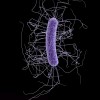Abstract
Opportunistic pathogens are significant health threats to vulnerable people with weakened immune systems, such as people with HIV/AIDS or those on immune-suppressing therapies. One opportunistic pathogen, Clostridium difficile, has been getting more attention in recent years because of its association with antibiotic use and high death rate in the elderly. This factsheet will provide an overview of Clostridium difficile infection (CDI) with a focus on healthcare-associated infections. This 5-page fact sheet was written by Soohyoun Ahn and Amarat H. Simonne, and published by the UF Department of Food Science and Human Nutrition, September 2014.
References
Arizona Department of Health Services. 2012. Clostridium difficile infections (CDI) prevention toolkit. http://www.azdhs.gov/phs/oids/hai/documents/HAIcommittee/cdiff-prevention-toolkit.pdf Last accessed on July 14, 2014.
Banas, JA. 2004. Virulence properties of Streptococcus mutans. Front Biosci 9:1267-1277. https://doi.org/10.2741/1305
Centers for Disease Control and Infection. 2013. Clostridium difficile infection. http://www.cdc.gov/hai/organisms/cdiff/cdiff_infect.html Last accessed on July 14, 2014.
Centers for Disease Control and Infection. 2014. Diseases and organisms in healthcare settings. http://www.cdc.gov/HAI/organisms/organisms.html Last accessed on July 11, 2014.
Chroneou, A., N. Zias, J. F. Beamis, Jr, and D. E. Craven. 2007 Healthcare-associated pneumonia: principles and emerging concepts on management. Expert Opin Pharmacother. 8:3117-3131. https://doi.org/10.1517/14656566.8.18.3117
Danziger-Isakov, L. 2014. Gastrointestinal infections after transplantation. Curr Opin Gastroenterol 30:40-46. https://doi.org/10.1097/MOG.0000000000000016
Dubberke, E. R., and D. N. Gerding. 2011. Rationale for hand hygiene recommendations after caring for a patient with Clostridium difficile infection. http://www.shea-online.org/Portals/0/CDI%20hand%20hygiene%20Update.pdf Last accessed on July 14, 2014.
Heron, M., D. L. Hoyert, S. L. Murphy, J. Xu, K. D. Kochanek, and B. Tejada-Vera. 2009. Deaths: final data for 2006. Natl Vital Stat Rep 57:1-134.
Hookman, P., and J. S. Barkin. 2009. Clostridium difficile associated infection, diarrhea and colitis. World J. Gastroenterol. 15:1554-1580. https://doi.org/10.3748/wjg.15.1554
Joint Commission Resources (JCR). 2012. Clinical care improvement strategies: preventing Clostridium difficile infections. http://www.jamesonhealth.org/sites/default/files/content/userfiles/JointCommissionPublicationPreventingC-difInfecions.pdf. Last accessed on July 14, 2014.
Kelly, C. P., and J. T. Lamont. 2014. Clostridium difficile in adults: treatment. http://www.uptodate.com/contents/clostridium-difficile-in-adults-treatment Last accessed on July 14, 2014.
Klevens, R. M., J. R. Edwards, C. L. Richards, Jr., T. C. Horan, R. P. Gaynes, D. A. Pollock, and D. M. Cardo. 2002. Estimating health care-associated infections and deaths in US hospitals. Public Health Rep. 122:160-166. https://doi.org/10.1177/003335490712200205
Knoop, F. C., M. Owens, and I. C. Crocker. 1993. Clostridium difficile: clinical disease and diagnosis. Clin. Microbiol. Rev. 6:251-265. https://doi.org/10.1128/CMR.6.3.251
Kyi, C., M. D. Hellmann, J. D. Wolchok, P. B. Chapman, and M. A. Postow. 2014. Opportunistic infections in patients treated with immunotherapy for cancer. J. Immunother Cancer. 2:19. https://doi.org/10.1186/2051-1426-2-19
Pagano, L., and M. Caira. 2012. Risks for infection in patients with myelodysplasia and acute leukemia. Currn Opin Infect Dis. 25:612-618. https://doi.org/10.1097/QCO.0b013e328358b000
Pruitt, B. A. Jr., A. T. McManus, S. H. Kim, and C. W. Goodwin. 1998. Burn wound infections: current status. World J. Surg. 22:135-145. https://doi.org/10.1007/s002689900361
Scott, R. D., II. 2009. The direct medical costs of healthcare-associated infections in US hospitals and the benefits of prevention. http://www.cdc.gov/hai/pdfs/hai/scott_costpaper.pdf Last accessed on July 14, 2014.
Sehulster, L., and R. Y. W. Chinn. 2003. Guidelines for environmental infection control in health-care facilities: recommendations of CDC and the Healthcare Infection Control Practices Advisory Committee (HICPAC). MMWR 52:1-42.
Siegel, J. D., E. Rhinehart, M. Jackson, L. Chiarello, and the Healthcare Infection Control Practices Advisory Committee. 2007. 2007 Guideline for isolation precautions: preventing transmission of infectious agents in healthcare settings. www.cdc.gov/hicpac/pdf/isolation/isolation2007.pdf Last accessed on July 14, 2014. https://doi.org/10.1016/j.ajic.2007.10.007
Steiner, C., M. Barrett, and L. Terrel. 2012. HCUP Projections: Clostridium Difficile Hospitalizations 2011 to 2012. 2012 HCUP Projections Report #2012-01. http://www.hcup-us.ahrq.gov/reports/projections/CDI_Regional_projections_Final.pdf Last accessed on Sep 2, 2014.
Tredget, E. E., H. A. Shankowsky, R. Rennie, R. E. Burrell, and S. Logsetty. 2004. Pseudomonas infections in the thermally injured patient. Burns 30:3-26. https://doi.org/10.1016/j.burns.2003.08.007

